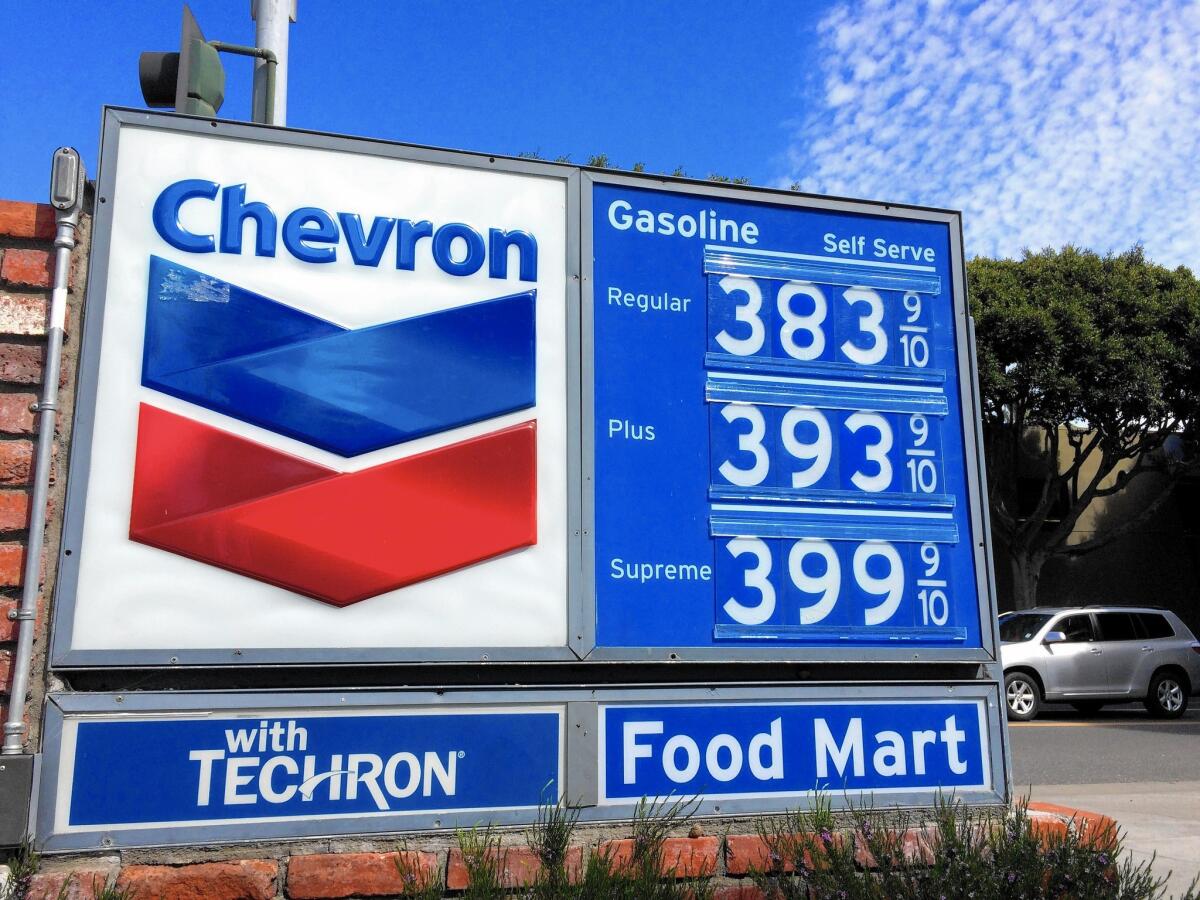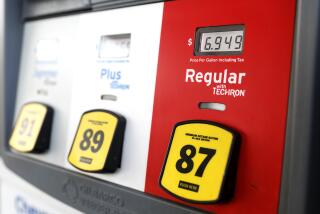In one month, gas prices in state have surged about $1 a gallon

California gas prices have shot up about $1 a gallon in the last month as oil refineries have been idled by a labor strike and an explosion.
That’s made gasoline much more expensive here than anywhere else in the nation — an average of $3.44 for a gallon of regular as of 7 a.m. Wednesday, according to price-tracker GasBuddy.com. Hawaii is the only other state with an average price above $3 a gallon.
Most of the increase came last week, including when the local price surged 14.3 cents Friday from Thursday. For the week that ended Monday, West Coast gas prices jumped a record 37.2 cents a gallon, according to the U.S. Energy Information Administration.
California’s increase nearly tripled the nationwide average over the past month. Drivers in Los Angeles are paying an average of $3.54 a gallon to fuel up, more than any of the other 443 metropolitan areas tracked by GasBuddy.
Part of the jump is driven by factors that always make California gas more expensive, such environmental controls on the types of fuels sold here, including the annual switch to a cleaner-burning summer blend. But the upswing largely reflects stoppages at oil refineries that account for about 17% of the state’s production capacity.
In early February, Tesoro Corp. decided to idle processing at its Martinez plant amid a nationwide strike at 15 oil and chemical refineries. Half the San Francisco Bay Area facility, which can handle 166,000 barrels of crude oil daily, had already been undergoing planned maintenance.
But California gas prices didn’t jump until an explosion at Exxon Mobil Corp.’s refinery in Torrance on Feb. 18. The blast sent ash into the air and caused minor injuries to four contractors.
The facility processes an average of 155,000 barrels a day and produces 1.8 billion gallons of gasoline a year — contributing as much as 20% of Southern California’s supply. Damage from the explosion has halted gasoline production in affected units at the facility. Exxon Mobil declined to say when it expects the facility to be fully operational.
The government’s energy agency said that the statewide market could take weeks to readjust to the sudden loss of production.
The resulting squeeze on supply means more profit for oil companies, according to Santa Monica-based Consumer Watchdog. The activist group has called for Tesoro and Exxon Mobil executives to be subpoenaed by legislators to explain “price gouging.”
“Angelenos are feeling the brunt of a statewide crisis — California oil refiners’ stranglehold on supply that gives them free rein to manipulate the market and spike prices even as crude prices remain low,” said Liza Tucker, the group’s consumer advocate.
The state Senate’s Energy, Utilities and Communications Committee and Environmental Quality Committee will hold a joint hearing Thursday night in Torrance to address safety issues surrounding the Exxon Mobil explosion. This month, the energy committee will pair with the Senate Transportation Committee to conduct a hearing about the incident’s effect on fuel pricing.
“The market was freaking out when the explosion happened,” GasBuddy analyst Allison Mac said.
California doesn’t import much gasoline because environmental regulations allow only specific types. Gasoline prices are often too volatile for foreign exporters to want to ship the fuel into California, according to the California Energy Commission.
Gasoline inventory in California tends to run low in the late winter and early spring, when fuel demand is low. Consumer Watchdog said California refineries keep just 10 days of gasoline supply on hand, compared with the national average of 24 days.
During the period, some of the state’s 20 major refineries slow or shut down for maintenance and to transition to the cleaner-burning summer blends from the cheaper, less-pure winter blends. (The switch happens nationwide, but much earlier in California — by April 1 — because of the state’s warmer weather.)
Gasoline prices probably will continue rising through the end of March or into early next month, analysts said. But as the market shakes off the shock of the Torrance explosion, price increases are already slowing to a few cents a day.
That’s largely because crude oil prices remain low because of a global glut, which sent prices plunging this summer.. After sinking below $50 a barrel in January, Brent crude settled Tuesday up 2.5% at $61.02 a barrel.
The government said crude oil inventories for this time of year are at their highest level in at least 80 years.
Despite the recent upswing, the price of a gallon of regular in California is still more than 40 cents lower than it was a year earlier. Before the refinery troubles began, California drivers were enjoying the lowest gas prices in six years, according to the Automobile Club of Southern California.
The all-too-brief period of affordable gasoline makes the recent price jumps all the more irritating, club spokeswoman Marie Montgomery said.
“It’s not pleasant,” Montgomery said. “We were hoping the low oil prices would keep the low gas prices around for a while.”
Twitter: @tiffhsulatimes







